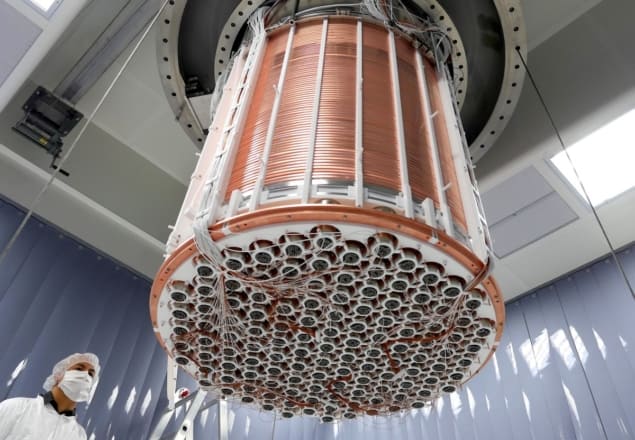
In June this year, physicists working on the XENON1T dark-matter detector announced the measurement of a curious signal in their experiment – which comprises 2 tonne of ultrapure xenon. The signal had a statistical significance of 3.5σ or less, which is well below the 5σ level that is usually required for a discovery in particle physics.
In a preprint published at the time, the team suggested that the signal – an excess in low-energy electron recoil events – could have three explanations. The most mundane is that it was caused by contamination of the ultrapure xenon by radioactive tritium.
A more intriguing explanation, they said, is that the signal is the detection of hypothetical particles called axions that could be emitted the Sun. The third possibility is that the excess is caused by neutrinos interacting with the xenon in an unexpected way – which would also be very interesting.
Now, the original preprint has been published in Physical Review D and over in Physical Review Letters, five theoretical papers put forth a range of tantalizing explanations for the excess.
Axionlike particle
Working in Japan, Fuminobu Takahashi, Masaki Yamada and Wen Yin say that the signal could be related to a hypothetical axion-like particle (ALP) with a mass of a few keV/c2 that interacts with electrons. As well as explaining the XENON1T signal, such an ALP could be a constituent of dark matter and its existence could explain an anomaly in the observed cooling of white dwarf and red giant stars.
Meanwhile, in Germany, Andreas Bally, Sudip Jana and Andreas Trautner reckon the mystery signal could be the work of a hypothetical gauge boson that mediates a new interaction between solar neutrinos and electrons.
A paper written by Nicole Bell et al. makes the case for a “relatively low-mass luminous dark-matter candidate” as the source of the excess. They suggest that this dark-matter particle could enter the detector in a “light state” and be scattered into a “heavy state” that would decay by emitting a photon. This photon would then interact with an electron in the detector to create the observed signal.
Galactic boost
Another dark-matter proposal comes from Bartosz Fornal and colleagues who suggest that otherwise sluggish cold-dark-matter particles could get a boost of energy from the galactic centre and collide with XENON1T electrons.
The fifth idea comes from Joseph Bramante and Ningqiang Song in Canada, who argue that the signal could come from the scattering of a type of dark matter that is a thermal relic from the early universe.
They can’t all be right, and it will be very interesting to see if a similar signal shows up in future dark-matter experiments.



